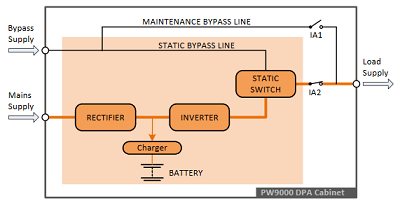If you’re trying to specify a UPS system, you’ll find yourself confronted, as with any technology, by a fair amount of jargon – which could be confusing if you’re not familiar with it. Our Jargon Buster below is intended to clear away any such confusion. Do write to us and let us know if there are any other terms you’d like to see explained or visit our Technical Glossary page.
Availability is a measure of how much time per year a UPS system is operational and available. UPS availability is a function of mean time between failures (MTBF) and of mean time to repair (MTTR). Availability can be improved both by increasing MTBF and by reducing MTTR. Figures of up to ‘six nines’ or 99.9999% are possible. For example, the KOHLER PW 9500DPA.
DPA or Decentralised Parallel Architecture refers to modular UPS systems where each UPS module contains all the hardware and software necessary for full system operation. With no common components or potential single points of failure, UPS systems with DPA design offer very high availability. For example the KOHLER PW 8000DPA.
Dual Path power distribution in a data centre delivers power to each IT equipment item through two independent power cables. This provides redundant backup if one cable fails, provided each cable is fed from a power source that can fully support the load if this happens.
Eco-mode Modern UPS systems can achieve up to 96% efficiency in normal dual conversion mode, and 99% or more in eco-mode. Eco-mode is when the incoming mains is routed directly through to the critical load. Efficiency is improved by eliminating conversion losses, but the downside is the risk of exposing sensitive equipment to potential raw mains power problems. Each IT facility operator must decide whether the reward outweighs the risk for their particular installation, considering the power quality history of the utility supply and the susceptibility of their on-site equipment.
Hot-swap modules can be safely plugged into or removed from a UPS system without having to interrupt power to the critical load or expose it to raw mains power. This reduces MTTR and increases UPS availability. The KOHLER PW 9000DPA has hot-swappable modules.
kVA or kilovolt-ampere (1000 volt-amperes) is a measure of the apparent power rating of a UPS or other power device. It is the vector sum of actual (or useful) power in kW, and reactive power. kVA relates to a UPS system’s maximum permissible current, while kW describes its power-handling capacity. The less reactive a load is the smaller the difference between its kVA and kW rating. See also Power Factor. To calculate your kVA load requirements, visit KUP’s kVA Calculator.
Module Early UPSs were monolithic, delivering all their power from a single functional unit. One failure within the unit would, therefore, cause a total loss of UPS availability. By contrast, most modern UPS power systems use topologies comprising a number of small, independent modules – allowing decentralised parallel architecture, redundant configurations and vastly improved availability. KUP sell a range of modular UPS systems.
Power Factor is the relationship between actual power (W or kW) and apparent power (VA or kVA), where power factor = W/VA. Ideal loads have unity power factors, while reactive loads have a power factor value between 0 and 1. Low power factors are undesirable as they create large reactive currents which increase energy costs and impose higher equipment ratings without performing useful work.
PUE or Power Usage Effectiveness is the ratio of total data centre energy consumption to the energy consumed by on-site IT equipment. An ideal PUE would be one; in practice, Google data centres have achieved PUEs as low as 1.12.
Redundancy is a strategy used, especially with modular UPS systems, to improve UPS availability. In an N+1 redundant system, for example, N UPS models are sufficient to entirely support the critical load. The ‘+1’ means that even if one module fails, N modules are still operational and the load remains fully supported; UPS availability is accordingly significantly increased.
Scalability Modular UPS systems are said to be scalable because they can easily be scaled to meet increased business, IT and power supply demands by plugging extra modules into the UPS racks as required. With hot swap modules, this can be achieved without having to interrupt power to the critical load.
KOHLER PW 9500DPA: An example of a scalable, modular UPS
Visit our Technical Glossary for the explanation of more terms within the industry.
Follow us on LinkedIn for regular industry articles & company information





